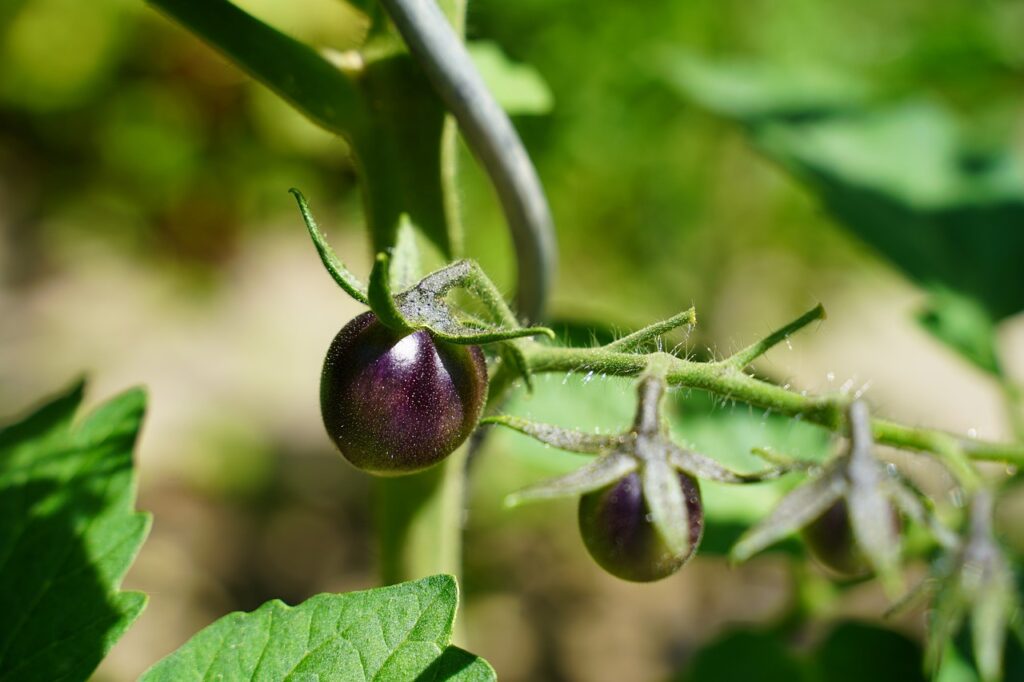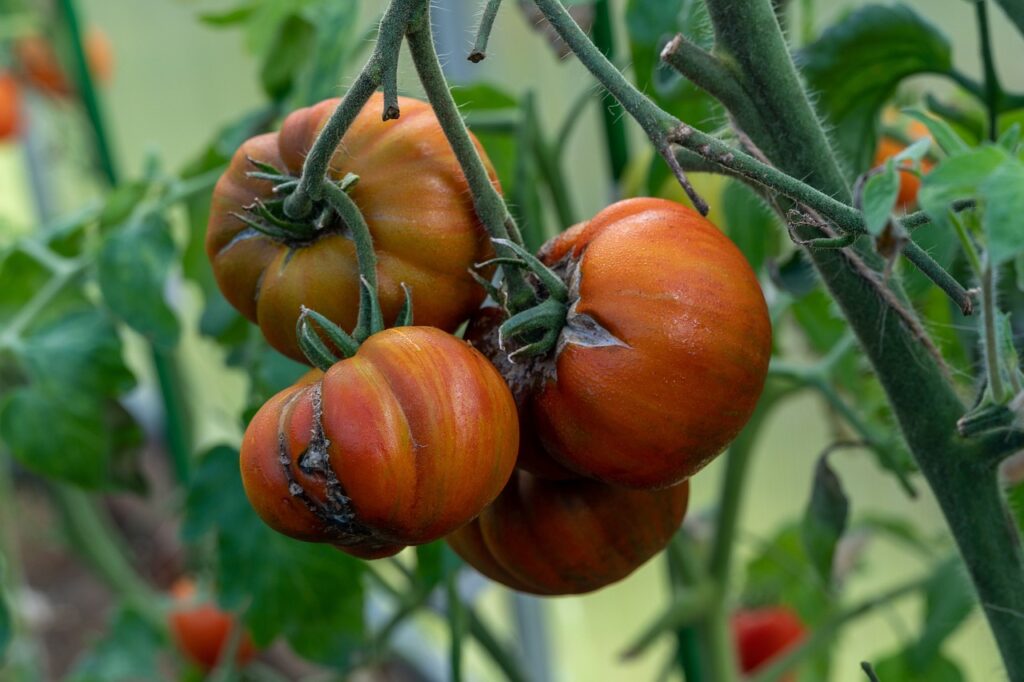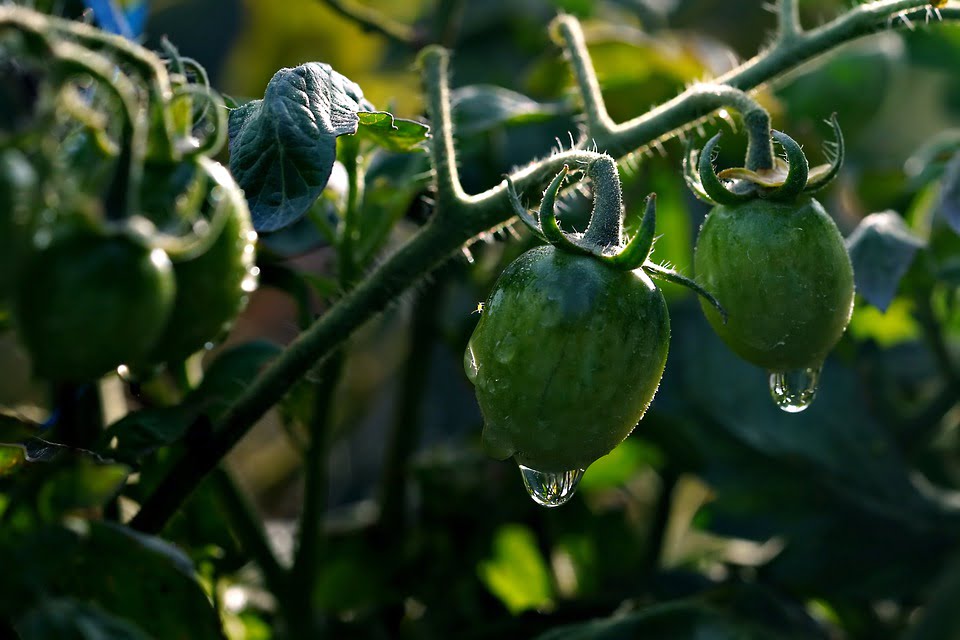Have you noticed a disconcerting purple hue creeping up the stems of your beloved tomato plants? Don’t panic just yet! While purple stems in tomato plants can be a cause for concern, it doesn’t necessarily spell disaster. This article will highlight seven main reasons why your tomato plant stems might be turning purple, and equip you with the knowledge to address the issue and get your plants thriving again.
Understanding the Significance of Color in Plants
Plants rely on a complex interplay of pigments to function. Chlorophyll, the green pigment, plays a vital role in photosynthesis, the process by which plants convert sunlight into energy. However, plants also contain anthocyanins, pigments that contribute to the vibrant reds, purples, and blues we see in fruits, flowers, and sometimes even stems.
7 Reasons Behind Purple Stems in Tomato Plants
Here are some common reasons your tomato steps are turning purple and the possible solutions:
1: Nutrient Deficiency (Phosphorus Deficiency Being the Main Culprit)
The most common reason for purple stems in tomato plants is a deficiency in phosphorus, a crucial nutrient for plant growth and development. Phosphorus plays a key role in various plant functions, including root development, energy transfer, and flower and fruit production. When phosphorus is in short supply, plants struggle to produce chlorophyll, leading to the green pigment being masked by anthocyanins, resulting in the characteristic purple coloration.
Symptoms of phosphorus deficiency, in addition to purple stems, include:
- Stunted growth: The plant appears smaller and grows slower than expected.
- Dark green or purplish leaves: Leaves may develop a darker green or even purplish tinge on the underside.
- Delayed flowering and fruiting: Fruit production may be delayed or sparse.
- Weak stems: Stems may become thin and brittle.

Solutions for Nutrient Deficiency (Phosphorus Deficiency):
- Balanced Fertilizer: Apply a balanced fertilizer containing phosphorus (NPK ratio). Look for fertilizers with a higher middle number (phosphorus) like a 5-10-10 or 8-24-10 can be beneficial.
- If your soil is generally balanced but you suspect a mild deficiency, a balanced fertilizer like a 10-10-10 might be sufficient.
- Organic Options: Organic gardeners can opt for natural phosphorus sources like bone meal, fish emulsion, or composted manure. However, these options release nutrients more slowly, so you may need to apply them earlier in the season or more frequently.
- Follow Instructions Carefully: Always follow the application instructions on the fertilizer label to avoid over-fertilizing, which can damage your plants.
2: Cool Temperatures
A temporary dip in temperature, particularly during the night, can also trigger purpling in tomato stems. This is a natural response by the plant to protect itself from cold stress. Anthocyanins are thought to act as a sort of antifreeze, helping to regulate cell temperature and protect plant tissues. While the purple coloration may be alarming, it’s usually a temporary response and doesn’t necessarily harm the plant.
Solutions for Cool Temperatures:
- Frost Protection: If you live in an area with unpredictable nighttime temperatures, consider protecting young tomato plants from frost with row covers, cloches, or even cardboard boxes.
- Greenhouse Option: For colder climates, starting your tomato plants indoors in a greenhouse or a sunny windowsill can help them establish a strong root system before transplanting outdoors.
3: Genetics
Believe it or not, some tomato varieties naturally have purple or anthocyanin-rich stems. These varieties are perfectly healthy and will still produce delicious tomatoes. Popular examples include:
- Black Cherry Tomato: This cherry tomato variety boasts dark purple stems and near-black fruit.
- Indigo Rose Tomato: This unique variety features deep purple stems and pinkish-purple fruits.
- Amish Paste Tomato: This heirloom variety is known for its reddish-purple stems and large, elongated fruits.
If you’re growing any of these varieties, the purple stems are likely a normal characteristic and not a cause for concern.
4: Light Stress
Tomato plants thrive in around 6-8 hours of daily sunlight. However, both excessive sunlight and insufficient light can lead to purpling in the stems.
- Too Much Sun: Intense sunlight can stress the plant, causing it to produce excess anthocyanins as a protective mechanism. This is more likely to occur during prolonged periods of hot weather.
- Not Enough Sun: When tomato plants don’t receive enough sunlight, they may struggle to produce chlorophyll, leading to purpling as the plant tries to compensate.
Solutions for Light Stress:
- Sun Exposure Adjustment: For plants receiving excessive sunlight, consider providing afternoon shade with shade cloth or by planting taller plants nearby.
- Relocation for More Sun: If your plants are not receiving enough sunlight, try relocating them to a sunnier spot in your garden. Alternatively, consider pruning nearby plants to create more space for sunlight to reach the tomatoes.
5: Magnesium Deficiency (Less Common)
While less frequent than phosphorus deficiency, a lack of magnesium can also cause purpling in tomato stems. Magnesium is essential for chlorophyll production and various plant functions. However, unlike phosphorus deficiency, where the entire leaf might turn purple, magnesium deficiency typically shows as yellowing leaves with green veins (interveinal chlorosis).
Solutions for Magnesium Deficiency:
- Epsom Salts Solution: Apply a solution of Epsom salts (magnesium sulfate) as a foliar spray or soil drench. Dissolve 1-2 tablespoons of Epsom salts per gallon of water and apply it directly to the leaves or water it around the base of the plant. Be sure to follow specific application rates to avoid overdoing it.
6: Physical Damage
Occasionally, localized purple discoloration on stems can be caused by physical damage. This could be due to accidental injury during pruning, insect bites, or even rubbing against support structures. While the discoloration might look concerning, it’s usually a cosmetic issue and doesn’t significantly impact plant health.

7: Disease (Rare Case)
In rare instances, diseases like Botrytis Blight (gray mold) can cause the stems and leaves of tomato plants to turn purple or brownish-purple. This is usually accompanied by other symptoms like rotting fruit, wilting, and fuzzy gray mold growth. If you suspect a disease, it’s best to consult a gardening professional for diagnosis and treatment recommendations.
Prevention is Key: Avoiding Purple Stems in the Future
By taking proactive measures, you can minimize the chances of your tomato plants developing purple stems:
- Soil Testing: Before planting, conduct a soil test to determine your soil’s nutrient levels. This will help you choose the right fertilizer and avoid deficiencies.
- Balanced Fertilization: Throughout the growing season, provide your tomato plants with a balanced fertilizer according to the needs of your specific soil and plant variety.
- Organic Matter: Amending your soil with organic matter like compost can help improve its nutrient content and overall health.
- Hardening Off: If you’re starting your plants from seeds indoors, ensure they are properly hardened off before transplanting them outdoors. This gradual exposure to cooler temperatures helps them adapt to the outside environment and reduces stress.
- Monitoring and Early Intervention: Regularly monitor your tomato plants for any signs of distress, including purple stems. Early detection and addressing the underlying cause can prevent the problem from worsening.
Wrapping Up
While purple stems in tomato plants can be alarming at first glance, it’s important to remember that it’s not always a sign of a serious problem. By understanding the various causes and taking appropriate action, you can often turn things around and ensure your tomato plants continue to thrive and produce delicious fruit. Remember, tomato plants are generally quite resilient, and with a little TLC, you can overcome this challenge and enjoy a bountiful harvest.

